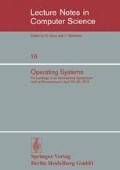Abstract
A formal model of the process concept is presented. This model can represent many sets of processes such as PV and its many generalizations. In this model the concepts of process and scheduler are separated. This separation allows one to make explicit many statements that otherwise would be implicit. In particular, this separation is used to study how schedulers enforce “fairness”, i.e., how schedulers can force certain actions to execute infinitely often.
Preview
Unable to display preview. Download preview PDF.
References
P. J. Courtois, F. Heymans, D. L. Parnas. Concurrent control with “readers” and “writers”. CACM 14(10):667–668.
P. Brinch Hansen. A reply on comments on “A comparison of two synchronizing concepts”, Acta Informatica 2:189–190.
P. J. Courtois, F. Heymans, D. L. Parnas. Comments on “A comparison of two synchronizing concepts by P. Brinch Hansen”. Acta Informatica 1:375–376.
R. J. Lipton. Limitations of synchronization primitives with conditional branching and global variables. To appear in Sixth Annual ACM Symposium on Theory of Computing, April 1974.
E. W. Dijkstra. Cooperating Sequential Processes, Programming Languages, edited by F. Genuys. 43–112.
A. N. Habermann. Synchronization of Communicating Processes. CACM 15(3):171–176.
H. Vantilborgh and A. van Lamsweerde. On an extension of Dijkstra's semaphore primitives. Information processing letters. 1:181–186.
S. S. Patil. Limitations and capabilities of Dijkstra's semaphore primitives for coordination among processes. Project MAC Computational Structures Group Memo 57.
E. W. Dijkstra. Unpublished manuscript.
P. Wodon. Still another tool for controlling cooperating algorithms. Carnegie-Mellon University Report.
J. H. Saltzer. Traffic Control in a Multiplexed Computer Systems, PhD thesis, MIT (Project MAC).
R. J. Lipton. On Synchronization Primitive Systems, Yale University Research Report #22.
E. W. Dijkstra. The Structure of the “THE” Multiprogramming System. CACM 11(5):341–347.
P. Brinch Hansen. A comparison of two synchronizing concepts. Acta Informatica 1:190–199.
R. J. Lipton. Reduction: A New Method of Proving Properties of Systems of Processes. In preparation.
Author information
Authors and Affiliations
Editor information
Rights and permissions
Copyright information
© 1974 Springer-Verlag Berlin Heidelberg
About this paper
Cite this paper
Lipton, R.J. (1974). Schedulers as enforces in synchronization processes. In: Gelenbe, E., Kaiser, C. (eds) Operating Systems. OS 1974. Lecture Notes in Computer Science, vol 16. Springer, Berlin, Heidelberg. https://doi.org/10.1007/BFb0029363
Download citation
DOI: https://doi.org/10.1007/BFb0029363
Published:
Publisher Name: Springer, Berlin, Heidelberg
Print ISBN: 978-3-540-06849-5
Online ISBN: 978-3-540-37805-1
eBook Packages: Springer Book Archive

